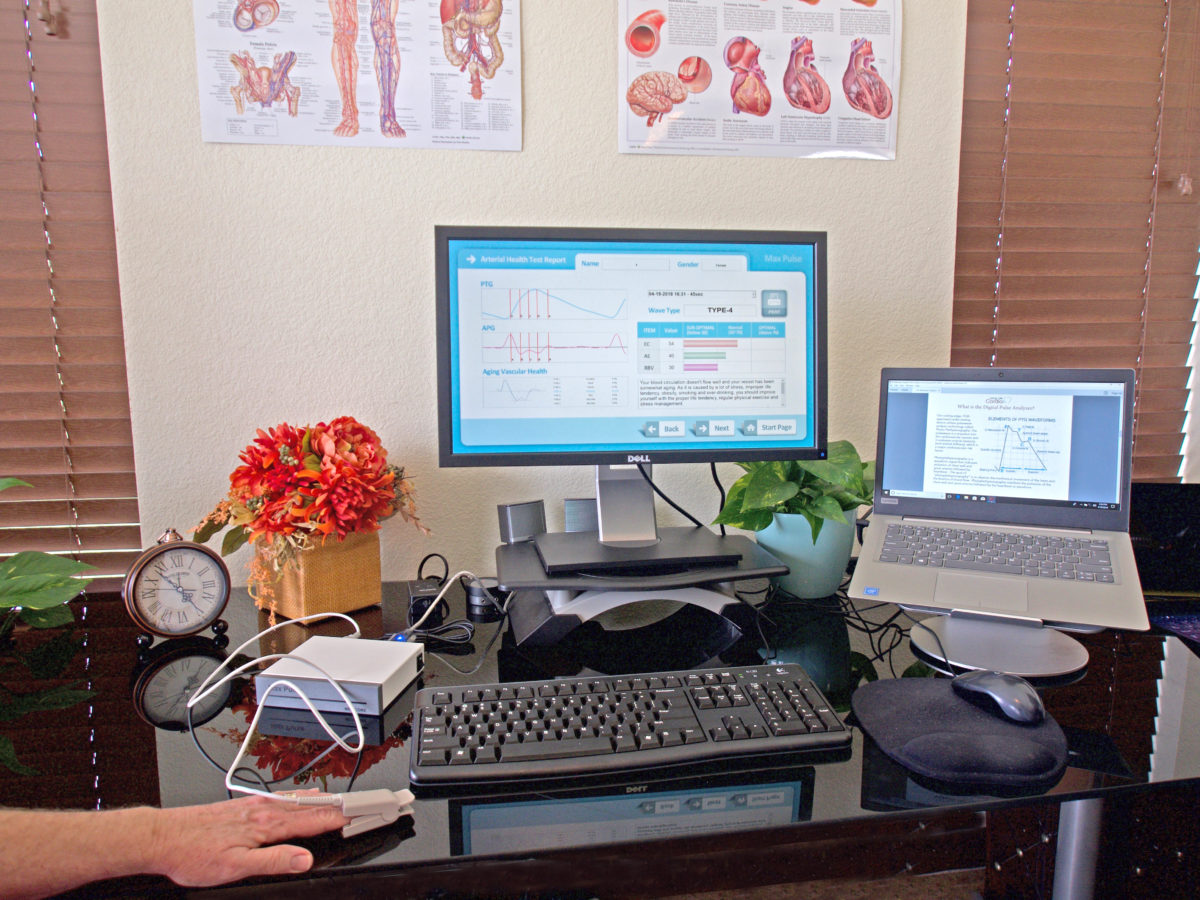- Early stage arterial hardening, so early that the condition is reversible giving patients an early wake up call and a chance to act.
- Early/mid stage heart weakening, the beginning of congestive heart failure, often when the patient is unaware, but is showing symptoms such as edema but has disregarded them.
- Late stage arterial hardening, sufficiently advanced that it is not easily reversible and may even require surgical intervention (such as stenting). This can be life saving. Our equipment will detect advanced arterial hardening before BP and other markers are definite.
Most Accurate Results
When Using the Max Pulse In Research Studies: When doing trials that require perfectly repeatable tests, you have to be very careful to follow the test instructions exactly. Follow the wait period after coffee, the no smoking before the test, and the person must have an empty stomach and the hands must be warm.
The empty stomach is important. When a person eats, the body constricts the arteries at the periphery to push blood into the body core. Then the body will tighten and loosen arteries continuously to maintain the optimum core blood levels for digestion. Tests taken while digesting will fluctuate because of this. The length of time after eating is important but different foods digest at different speeds so its also important that the person reports that they have an empty stomach.
Cardiovascular Mortality Rates on the Rise Again Due to Obesity

What’s also alarming is that while cardiovascular disease-related deaths declined by 36% from 2000-2014 overall, the mortality rates began increasing for the first time between 2011 and 2014 and have now reached a plateau despite a drastic decrease of smokers in the general population. This is causing increases in mortality rates due to hypertension, diabetes, and kidney disease, all of which contribute to cardiovascular disease risk. The American Heart Association hoped to see at least a 20% continued decrease of CVD related deaths by 2020, however, it appears that goal will not be met.
Dr. Steven Nissen, esteemed chairman of the Cleveland Cardiovascular Clinic, researcher, and patient advocate, weighs in on this topic:
“We have to attack this problem before it gets to the point where people are really obese and in trouble. Because once people have developed severe obesity, reversing that is very difficult.” Early intervention is also key since chronic disease can be diagnosed, treated, and possibly reversed if it is caught in time.”
Continued education and programs regarding nutrition, exercise, and overall health and wellness is key for Americans to lose weight and become healthier. However, early intervention is also key since chronic disease can be diagnosed, treated, and possibly reversed if caught in time.
The Max Pulse Screening Device

The Max Pulse shows accurate assessment of arterial hardening, and an indication of whether circulation is inhibited. There is a separate result for large arteries, small arteries, and capillaries. This information is very valuable to a practitioner. Larger arterial constriction and arterial hardening at the same time is of course, a huge cause of concern.
Additionally, this machine does a very accurate heart rate variability test and prints an autonomic nervous system analysis which shows if the patient is overstressed and whether or not the sympathetic nervous system is dominant, or in some cases showing that the person is inhibited or suppressed and the parasympathetic system is dominant.
For more detailed information about the Max Pulse, please visit us at our website and learn how the Max Pulse can help your patients. Our representatives will be happy to discuss our device with you. We can answer all of your questions and show you the incredible benefits this device can have for your practice.
Please Call Us at (210) 601-1050
Or Write to Us Here:
Max Pulse Testing Directory
You might have found our website looking for someone to give you the Max Pulse test. There is no directory for this, so we have decided to start one.
We will be adding more and more names and locations to this directory as time goes on.
Max Pulse Device for GPs and Family Practices
One of the biggest challenges that physicians face is treating and managing cardiovascular disease. More Americans die each year from CVD related problems than from any other disease. In many cases, patients are asymptomatic, or they aren’t aware of the severity of their disease until disaster strikes.
The World Health Organization has completed several studies on identifying and managing risk factors of cardiovascular disease, along with the obstacles that doctors encounter:
“The debilitating and often fatal complications of CVD are usually seen in middle-aged or elderly men and women. However, atherosclerosis, the main pathological process leading to coronary artery disease and peripheral artery disease beings early in life and progresses gradually through adolescence and early adulthood. It is usually asymptomatic for a long period.”
“…many people are unaware of their risk status; opportunistic and other forms of screening by healthcare providers are therefore a potentially useful means of detecting risk factors…”. Read more about this study and its findings at www.who.int/cardiovascular_diseases/guidelines/Full%20text.pdf.
General Practice Physicians frequently screen for cardiovascular disease by testing lipids, blood sugar, and regular blood pressure monitoring. However, the Max Pulse is an additional screening tool for cardiovascular disease that actually offers insight into the state of atherosclerosis in a patient.
The test is non-invasive, inexpensive, and takes approximately 3 minutes making it convenient for the doctor and the patient. Additionally, results print out instantly and can be reviewed with the patient right after it is completed.
This is a good tool to use in the course of regular check-ups regardless of age since it can help identify early signs of atherosclerosis. Additionally, it should be used with patients who have a known history and/or risk of CVD and can even help track progression from visit to visit. The Max Pulse should also be used in patients with diabetes as part of their regular testing program.

